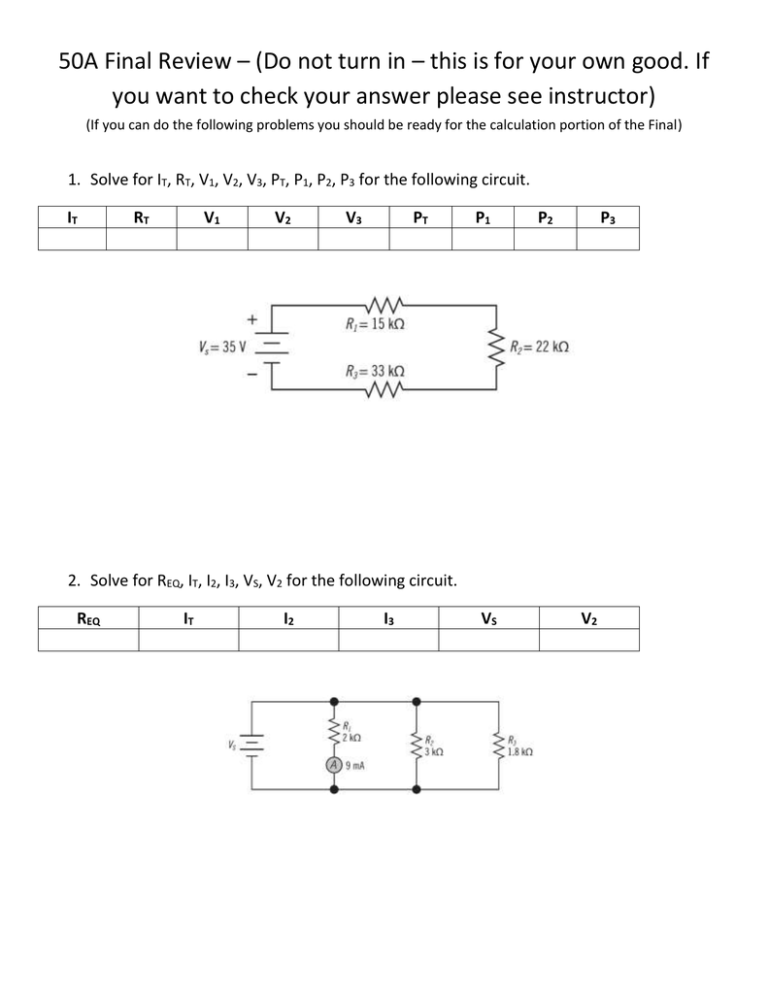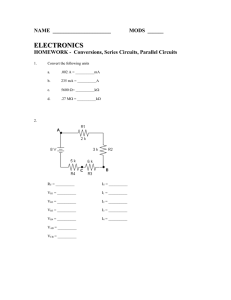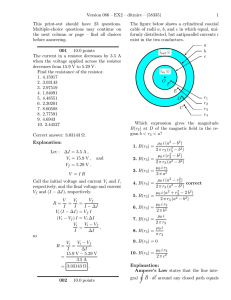50A Final Review – (Do not turn in – this... you want to check your answer please see instructor)
advertisement

50A Final Review – (Do not turn in – this is for your own good. If you want to check your answer please see instructor) (If you can do the following problems you should be ready for the calculation portion of the Final) 1. Solve for IT, RT, V1, V2, V3, PT, P1, P2, P3 for the following circuit. IT RT V1 V2 V3 PT P1 P2 P3 2. Solve for REQ, IT, I2, I3, VS, V2 for the following circuit. REQ IT I2 I3 VS V2 3. Determine REQ, IT, I1, I2, I3, I4, V1, V2, V3, and V4. REQ IT I1 I2 I3 I4 V1 V2 V3 V4 4. Determine all unknown currents and indicate their direction with an arrow on the schematic below. 5. Determine I1, I2, and I3. I1 I2 6. Determine VR1 using the superposition theorem. VR1 I3 7. Determine VR1, VR2, and VR3 using mesh currents. VR1 VR2 VR3 8. Determine VRL and IRL using Thevenin’s theorem. VRL IRL 9. Determine VRL and IRL. VRL IRL 10. Solve for RT, IT as well as I1 thru I5, V1 thru V5 and P1 thru P5: R2 70Ω V1 60 V R1 40Ω R3 30Ω R4 45Ω R5 50Ω R1 = 40 I1 V1 P1 R2 = 70 I2 V2 P2 R3 = 30 I3 V3 P3 R4 = 45 I4 V4 P4 R5 = 50 I5 V5 P5 RT = IT VT = 60V PT Other concepts that may be on the final: (This list is not completely exhaustive, but pretty close) Be able to build a circuit on a breadboard, and make current, voltage and resistance measurements with both the VOM and the DMM. In a parallel circuit, which branch has the largest current? An ideal voltmeter has infinite or zero ohms of internal resistance? Why? Does a DMM have a fixed internal resistance, or one that changes with voltage? How does the internal resistance of a VOM change? Be able to explain how loading effects, affect circuits. Define Kirchoff’s Voltage Law What does it mean to have a negative current? Be able to explain what a balanced and unbalance Wheatstone Bridge is. Be able to do the techniques taught in chapter 12. (Superpostion, Mesh Analysis, Thevenin, Max Power) The schematic below is of a 50kΩ potentiometer. Pins 1 and 2 are shorted together with a wire. If the resistance across pins 1 and 2 was 8kΩ before the wire was placed there, what is the resistance from pins 2 to 3? From pins 1 to 3 with and without the wire in place? In the parallel circuit below, if one of the resistors was removed, what would happen to the total resistance? What would happen to the total current? What would happen to the current in the remaining resistors? What is the advantage to having batteries connected in parallel rather than in series? What is a voltage divider? What is a loaded voltage divider? Be able to design one given certain parameters. Understand Maximum Power Transfer. What is the value of the internal resistance of a VOM with a sensitivity of 20kOhm/V if the scale is set to 250V and it is measuring across a resistor whose voltage is 100V (Vs = 1000V) In the circuit below, if all voltages were calculated, what is wrong with the values labeled in the circuit, and why? Assuming a 20 % bleeder current of ILT , what would be the value of R2 in the circuit below? R2 =_________ Ω





